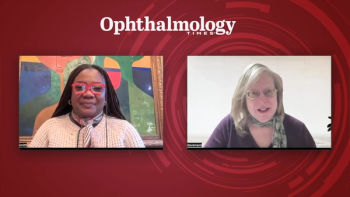
Genentech announces 5-Year data of susvimo for wet AMD from Portal study
Key Takeaways
- Genentech's Portal study shows Susvimo maintains vision and retinal drying in wet AMD patients over five years with biannual refills.
- The study involved 352 participants, with 95% requiring no supplemental treatment between six-month refills, demonstrating Susvimo's durability.
The Portal study is a long-term extension of the phase 3 Archway study
Genentech recently announced 5-year efficacy, safety, and durability data from its phase 3 Portal study for the evaluation of Susvimo (ranibizumab injection) for the treatment of people with
“The long-term results reinforce Susvimo’s ability to maintain vision and retinal drying over a long period of time for people with wet AMD, the leading cause of vision loss in people over age 60,” Levi Garraway, MD, PhD, Genentech’s chief medical officer and head of Global Product Development, said in a press release.1
“The robust data reinforce our confidence in Susvimo’s unique therapeutic approach, providing an effective alternative to regular eye injections while preserving vision in a sustained manner.”
Results showed Susvimo’s “immediate and predictable durability was sustained over five years, with approximately 95% of people receiving treatment every six months requiring no supplemental treatment before each refill,” a press release said. While enrolled in the Portal study (n = 352), patients originally treated with Susvimo in Archway continued to receive Susvimo refills every 6 months (Susvimo cohort; n = 220), while the others originally treated with monthly intravitreal (IVT) ranibizumab injections in Archway received Susvimo and then refills every 6 months (IVT-Susvimo cohort; n = 123).1
The five-year results demonstrated consistent and sustained disease control and retinal drying in a population who entered Archway with vision at or near peak levels after receiving an average of 5 intravitreal injections per standard of care. The Susvimo cohort's best-corrected visual acuity (BCVA) was 74.4 letters at baseline and 67.6 letters at 5 years. Comparatively, the IVT-Susvimo cohort BCVA was 76.3 letters at baseline and 68.6 at 54 years. Using the Snellen visual acuity test, half of all patients had better than 20/40 vision at 5 years. Average central subfield thickness (CST) remained stable in the Susvimo cohorts, with a 1.0 (95% CI: -13.1, 11.1) µm reduction from baseline in the Susvimo cohort and a 4.2 (95% CI: -25.7, 5.0) µm reduction in the IVT-Susvimo cohort.1
Using the Port Delivery Platform, a refillable eye implant placed via a one-time outpatient procedure, Susvimo gives continuous delivery of a customized formulation of ranibizumab. Comparatively, other currently approved treatments may require monthly eye injections.
“People with wet AMD often experience suboptimal outcomes with real-world anti-VEGF treatment, largely due to the frequency of injections,” said study investigator John Kitchens, MD, Retina Associates of Kentucky, who presented the data at ASRS. “Continuous delivery of treatment with Susvimo may preserve vision in patients with wet AMD for longer in real-world clinical use than IVT injections.”
Warnings and precautions:
According to the company, the Susvimo implant and the procedures associated with inserting, filling, refilling, and (if medically necessary) removing the implant can cause other serious side effects, including:¹
- Endophthalmitis: an eye infection
- Conjunctival erosion: a mission layer on top of the white part of the eye
- Conjunctival retraction: an opening of the layer that covers the white part of the eye
- Rhegmatogenous retinal detachment: a tear and separation of layers of the retina
- Implant dislocation: movement of the implant
- Vitreous hemorrhage: bleeding
- Conjunctival bleb: a bump on top of the white layer of the eye
- Temporary decrease in vision after the procedure
The most common adverse reactions were blood on the white of the eye, redness in the white of the eye, sensitivity to light, and eye pain. Patients should use birth control during treatment with Susvimo and for 12 months following the last refill of Susvimo, as it is not known if Susvimo will harm an unborn baby.1
Patients who have an infection in or around their eye, have active inflammation in
Reference:
Genentech’s Susvimo Maintains Vision Over Five Years With Two Refills Per Year in People With Wet Age-Related Macular Degeneration (AMD). Businesswire.com. Published August 2025.
https://www.businesswire.com/news/home/20250801344271/en/Genentechs-Susvimo-Maintains-Vision-Over-Five-Years-With-Two-Refills-Per-Year-in-People-With-Wet-Age-Related-Macular-Degeneration-AMD
Newsletter
Don’t miss out—get Ophthalmology Times updates on the latest clinical advancements and expert interviews, straight to your inbox.





